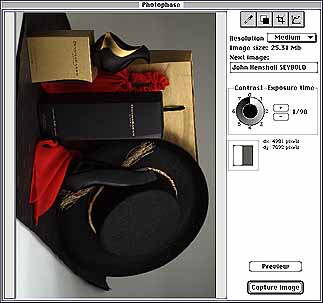
The Photophase user interface is large and clear - but landscape format shots are shown rotated.
The new Photophase FC70 back, which fits into a
standard large format spring-back loading system - again, like a normal
film cassette. Changing between ground glass, film and digital is thus easy,
very useful if you want both digital and film versions of the same subject.
Capture area is 2.8 by 3.9 inches, which makes the image format slightly
wider than true 4:5 format. Perhaps significantly, this is almost identical
to the ratio of European paper sizes.
The user interface has been redesigned and provides a superb preview image
which should be a model for all those who write user interfaces for scanners
and cameras. One criticism: with a landscape picture the image was rotated
through 90° on the screen. It would give me a pain in the neck long
before the end of a long day of shooting.

I scanned a 26mb file of the set-up on the PhotoPhase booth in just over
four minutes, to produce the accompanying illustration. It compressed down
to only 368 kilobytes - one seventieth of its original file size - using
exactly the same compression technique as that used for the Dicomed
shot. The PhotoPhase file compresses more because of the broad areas
of gold, black and grey - subjects which would very soon show up any problems
with the camera and, to Phase One's credit, a brave subject to tackle. Lighting
was by Broncolor HMI softboxes.
